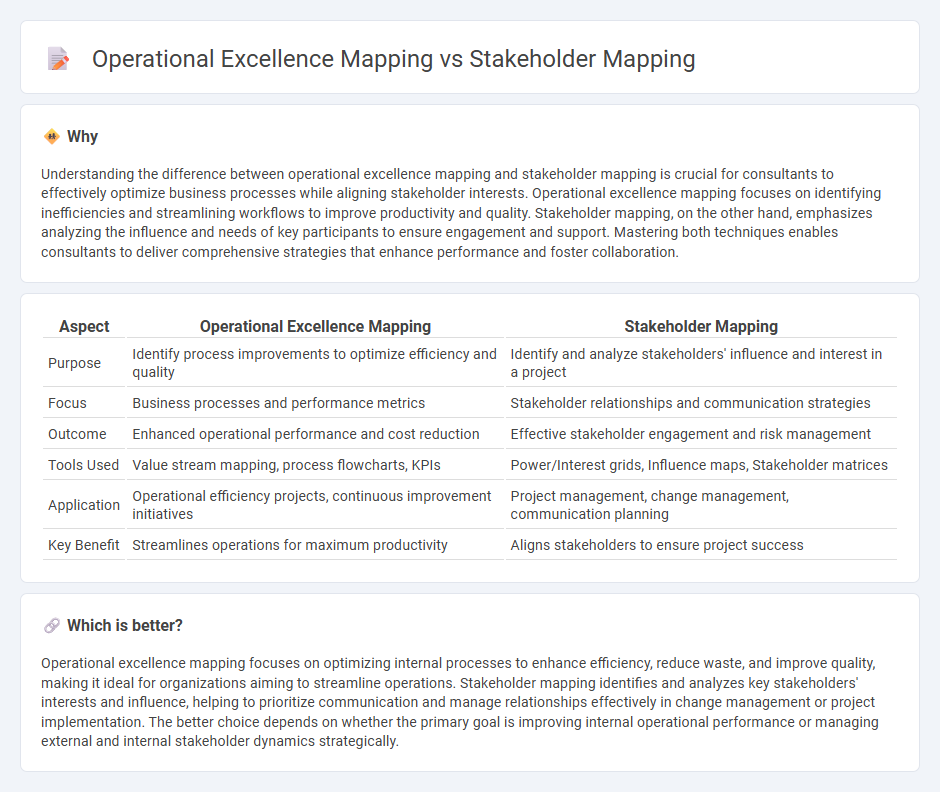
Operational excellence mapping focuses on identifying and improving internal processes to maximize efficiency, reduce waste, and enhance productivity across business functions. Stakeholder mapping, by contrast, prioritizes understanding the influence, interests, and expectations of key stakeholders to align strategies and foster effective communication. Explore these methodologies in depth to determine which approach best drives your consulting goals.
Why it is important
Understanding the difference between operational excellence mapping and stakeholder mapping is crucial for consultants to effectively optimize business processes while aligning stakeholder interests. Operational excellence mapping focuses on identifying inefficiencies and streamlining workflows to improve productivity and quality. Stakeholder mapping, on the other hand, emphasizes analyzing the influence and needs of key participants to ensure engagement and support. Mastering both techniques enables consultants to deliver comprehensive strategies that enhance performance and foster collaboration.
Comparison Table
| Aspect | Operational Excellence Mapping | Stakeholder Mapping |
|---|---|---|
| Purpose | Identify process improvements to optimize efficiency and quality | Identify and analyze stakeholders' influence and interest in a project |
| Focus | Business processes and performance metrics | Stakeholder relationships and communication strategies |
| Outcome | Enhanced operational performance and cost reduction | Effective stakeholder engagement and risk management |
| Tools Used | Value stream mapping, process flowcharts, KPIs | Power/Interest grids, Influence maps, Stakeholder matrices |
| Application | Operational efficiency projects, continuous improvement initiatives | Project management, change management, communication planning |
| Key Benefit | Streamlines operations for maximum productivity | Aligns stakeholders to ensure project success |
Which is better?
Operational excellence mapping focuses on optimizing internal processes to enhance efficiency, reduce waste, and improve quality, making it ideal for organizations aiming to streamline operations. Stakeholder mapping identifies and analyzes key stakeholders' interests and influence, helping to prioritize communication and manage relationships effectively in change management or project implementation. The better choice depends on whether the primary goal is improving internal operational performance or managing external and internal stakeholder dynamics strategically.
Connection
Operational excellence mapping enhances process efficiency by identifying key activities and performance metrics, which aligns with stakeholder mapping that pinpoints individuals or groups influencing or affected by these processes. Understanding stakeholder interests and expectations helps tailor operational strategies to meet their needs, driving continuous improvement and organizational success. Integrating both mappings ensures targeted resource allocation and effective communication channels, boosting overall operational performance.
Key Terms
Influence Matrix (Stakeholder Mapping)
Stakeholder mapping uses the Influence Matrix to categorize stakeholders based on their power and interest, enabling targeted engagement strategies. Operational excellence mapping prioritizes process efficiency and performance improvement without explicitly mapping stakeholder influence. Explore how integrating Influence Matrix into operational excellence can enhance strategic decision-making and stakeholder alignment.
Process Flow Analysis (Operational Excellence Mapping)
Operational Excellence Mapping emphasizes Process Flow Analysis by visually detailing workflows, identifying inefficiencies, and streamlining operations to enhance productivity. In contrast, Stakeholder Mapping centers on understanding relationships, influences, and interests among project participants without dissecting the process steps. Explore Process Flow Analysis techniques to maximize operational efficiency and achieve business goals effectively.
Engagement Strategy (Stakeholder Mapping)
Stakeholder mapping identifies and prioritizes key individuals and groups to tailor engagement strategies that enhance collaboration and communication effectiveness. Operational excellence mapping focuses on optimizing processes and performance metrics for improved organizational efficiency without directly addressing stakeholder engagement. Explore how integrating stakeholder mapping with operational frameworks can drive both engagement and operational success.
Source and External Links
What is Stakeholder Mapping? Techniques and Steps - SixSigma.us - Stakeholder mapping is a strategic tool used to visualize and analyze relationships between parties in a project, involving identification, analysis of characteristics, and prioritization of stakeholders to improve engagement strategies and project outcomes.
Stakeholder Mapping: Guide to Identifying & Engaging Key ... - Stakeholder mapping involves identifying and categorizing stakeholders by their shared interests and needs to tailor communication efforts effectively and ensure all key stakeholders are included.
How to create a stakeholder map [templates & examples] - Mural - Stakeholder maps visually represent stakeholders and their relationships using tools like grids or network diagrams, helping to understand influence, interest, and connections for better communication and project management.
 dowidth.com
dowidth.com